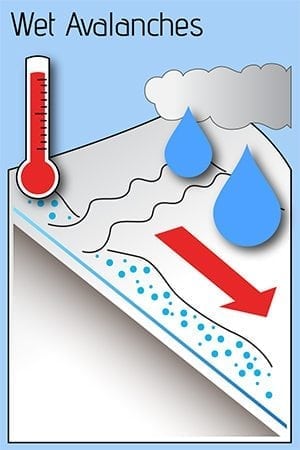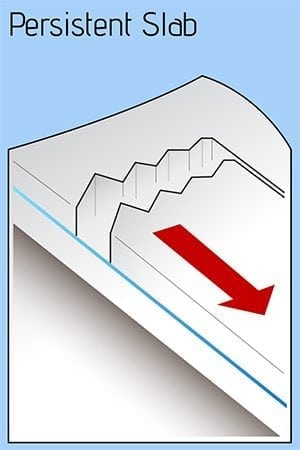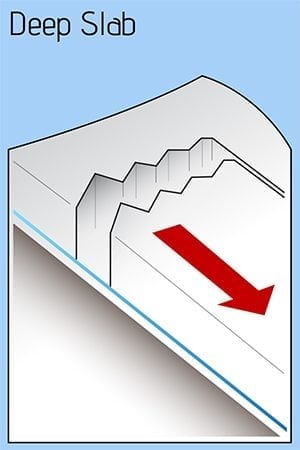Valdez
Above 4,000ftConsiderable
2,000 to 4,000ftConsiderable
Below 2,000ftConsiderable
The Avy Rose shows the forecasted danger by elevation and aspect. It adds more detail about where you are likely to find the dangers mentioned in the forecast. The inner circle shows upper elevations (mountain top), the second circle is middle elevations, and the outer circle represents lower elevations. Think of the Rose as a birds-eye view of a mountain, looking down from above. The rose allows our forecasters to visually show you which parts of the mountain they are most concerned about.
Degrees of Avalanche Danger
Avalanche Problems
Problem 1
The spring shed cycle is in full affect. Expect steep south aspects to produce significant avalanche activity at all elevations during the heat of the day. Other aspects will become reactive as they move into direct sunlight.
There are plenty of clues as to what time of day this avalanche problem is an issue. Moist/wet snow that is more than a few inches deep indicates the potential for wet avalanches. Roller balls, snow snails and natural activity are other great indicators that it is time to move towards more shaded aspects. The depth of hot snow required to make an avalanche directly correlates with the steepness of the slope. Less wet snow is required to produce an avalanche in steeper terrain with more vertical relief due to higher angles being able to absorb more heat and wet snows ability to entrain significant mass. South aspects are the most suspect.
Wet loose avalanches will be unlikely at the start of the day and become likely as the day progresses depending upon aspect and elevation. It is possible to mitigate this avalanche problem by paying attention to where the sun is in the sky, and watching what slopes are currently being warmed then planning your travel accordingly. East aspects are the first to heat up in the day followed by south and eventually moving around the compass to northwest in the evening. Aspects that are perpendicular to the sun are receiving the most effect.
Depending upon the terrain, wet loose avalanches have the potential to entrain significant amounts of snow and cause step downs to deeper layers in the snowpack (see problem 3). Even small wet loose avalanches can contain more force than expected and can carry you off of your feet or machine and carry you downhill.
Likelihood:
- Almost Certain
- Very Likely
- Likely
- Possible
- Unlikely
Size:
- Historic
- Very Large
- Large
- Small
Trend
- Increasing
- Steady
- Decreasing
Problem 2
Our most recent snowfall on 4/21-22 left us with 2-12 inches of new above 4000′. On north aspects above 5000′ near surface facets have been found beneath the new snow that remain reactive to human triggers in specific locations. Human triggered avalanches have been observed and reported below ridge lines and on convex terrain features. Remember that even shallow avalanches can have big consequences when above terrain traps or exposure.
Human triggered storm slab avalanches will be possible today up to 12 inches in depth. Protected north aspects above 5000′ are the most suspect.
Likelihood:
- Almost Certain
- Very Likely
- Likely
- Possible
- Unlikely
Size:
- Historic
- Very Large
- Large
- Small
Trend
- Increasing
- Steady
- Decreasing
Problem 3
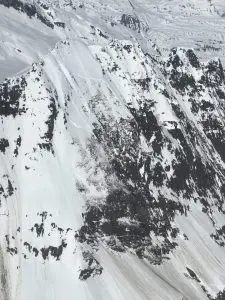
Natural D3 wet slab avalanche SE aspect/ Woodworth glacier/ ~4500′.
Weak faceted snow at the base of our snowpack (November facets) that has produced significant avalanche activity earlier in the season is once again becoming reactive on south aspects. Rising temperatures that are forecasted over the next week will allow for heat to penetrate deeper into the snowpack. This will slowly increase the likelihood to see deep slab avalanche activity at the November facets. South aspects have become reactive and west aspects may begin to see activity in the coming days. Large loads such as cornice, rock or serac fall have the potential to trigger deep slab avalanches on all aspects and forecast zones. The best way to mitigate this hazard will be to avoid specific terrain and hazards. Steep south faces should be avoided during the heat of the day as well as slopes with overhanging cornices.
Likelihood:
- Almost Certain
- Very Likely
- Likely
- Possible
- Unlikely
Size:
- Historic
- Very Large
- Large
- Small
Trend
- Increasing
- Steady
- Decreasing
Problem 4
As the Spring progresses and temperatures get warmer the likelihood for cornices to fall increases. These can range from just small chunks to school bus size pieces. Falling cornices have the potential to affect layers deep in the snowpack and create deep slab avalanches (see problem 3). A near miss cornice fall incident occurred on 4/26 that involved a party of three on Acapulco (see avalanche activity section for limited details and photos).
It is best to avoid exposure to this avalanche problem altogether as they can fail during random times of day. Avoid standing on top of overhanging cornices, these can fail much further back on a ridge line than you may expect. Give them a wide berth. Avoid traveling beneath cornices as much as possible.
Likelihood:
- Almost Certain
- Very Likely
- Likely
- Possible
- Unlikely
Size:
- Historic
- Very Large
- Large
- Small
Trend
- Increasing
- Steady
- Decreasing
Avalanche Activity
On the twenty fifth day of April a human triggered avalanche took the life of a Beloved local Vadez heli ski guide. Details are limited at this point. Avalanche occurred at ~5800′ on a NW aspect in the Pencil glacier. Skier triggered a storm slab near ridgeline which carried them over exposure. Near surface facets at the new snow/old interface are the suspected weak layer.
4/26- A near miss occurred on Acapulco where 3 skiers were partially buried. Details are limited, but indicate that the party caused a ridge line cornice failure causing them to tumble down the west face. Cornice fall produced a large avalanche that stepped down twice.

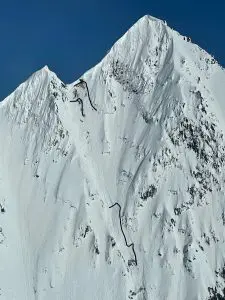
Snowslide Gulch produced a D3 wet slab avalanche that put debris on the highway and has temporarily dammed the river. November facets are the suspected weak layer.
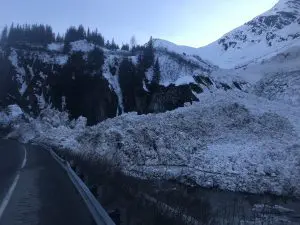
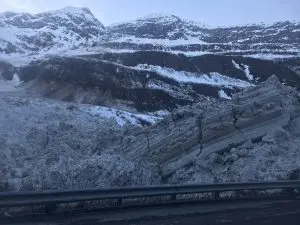
4/24- DOT reported a natural avalanche that covered Dayville road for 50′ with up to 12′ of debris. Slide originated at low elevation close to the road.
Snowslide Gulch produced significant wet loose debris that triggered wet slab avalanche activity.
4/12- Natural cornice fall was reported on Saphire that triggered a D2 deep slab on a north aspect at 6000 feet.
4/11- Human triggered wind slab avalanches have been reported below ridgelines and on cross loaded terrain feature mid slope. These have mostly been shallow with narrow propagations ( 4-8 inches deep and 15-30 feet wide). Although there was a larger slide reported on 40.5 mile peak up to D2 with depths of 1-3 feet propagating ~150 feet.
4/9- Human triggered avalanches to size D2 have been reported failing at the 4/5 new/old interface up to 3 feet in depth. Activity has been concentrated to northerly aspects in the mid elevation band.
Photo of skier triggered D2 in a cross loaded gully on Python lowers, north aspect, ~3000′
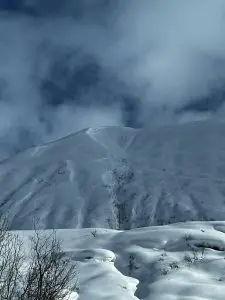
4/7- Numerous natural storm slab avalanches were observed on every aspect below ridge lines and on steep rolls in the mid elevations. All slides observed included the new snow with no step downs observed or reported. Natural activity was more concentrated towards the continental forecast zone where faceting of the surface snow during the last clear cycle was more significant.
There were a couple remote triggered D1-2 avalanches reported on northerly aspects at mid and upper elevations as well as multiple human triggered slides. Locations were not reported.
3/30-4/2- Cornice fall has been reported in isolated locations with significant loose snow entrainment or slab avalanches resulting.
Witnessed a Natural D2 avalanche resulting from cornice fall on a north aspect of pt 6330 just SW of Elephant. No slab observed, just significant entrainment.
3/26- Details are very limited at this time, but there was a near miss in Gully 1 on Saturday 3/26. Two people were fully buried and one partially. A group in close proximity witnessed the avalanche and was able to dig the party out without incident.
3/29- Natural D2 avalanches off south aspects of Three Pigs. Some of these stepped down and produced slab avalanches.
Several D1-1.5 skier triggered avalanches were reported across the forecast area within the storm snow and wind slabs.
3/23- Skier triggered wind deposit reported in the Iguana Backs at ~4000′ on a NW aspect. Slide didn’t go anywhere because it was initiated from terrain less than 30°. Deposit was 2.5 feet deep at the deepest spot and was reported as failing on buried surface hoar.
3/22- Skier triggered D2 windslab avalanche on a west aspect near schoolbus.
3/21- Numerous natural D1 windslab pockets reported releasing from W-N-E mid and low elevation convexities.
3/20- Natural D3 hard slab NE of Averys

3/18- Ski cuts have been reported as productive at the new/old interface from 3/15. These have been small and in the 6-8 inches deep.
3/7- More skier triggered avalanches, mostly D1-D2’s failing at the 3/3 BSH.
A local snowmachiner that was traveling through Marshall Pass reported a very notable natural deep hard slab that failed at the November facets. Avalanche occured on a North aspect between the Schwan and Woodworth glaciers failed at the ground and ran into the Tasnuna river valley. Avalanche was estimated as D3-D4 with a crown depth over 10 feet.
Another deep hard slab released naturaly on a high south aspect ~5500′ behind Averys.
3/6- Numerous skier triggered D1-D2 avalanches occured failing at the new snow/old snow interface on surface hoar buried 3/3. Ski cuts were reported to be very productive with sensitivity ranging from touchy to very touchy. Most of these avalanches occured further back from the road corridor. Although, one notable skier triggers D2.5 occured on Cracked Ice on a north aspect at ~4000′ that appeared to be 1000 + feet wide. D1 naturals occured on 40.5 mile.

3/5- Numerous D1-D2 natural avalanches occured within the storms now 1-2 feet deep. These occured mostly on northern half of the compass. Including Little and big oddesssey, Gully 1, Mt Dimond moraine and Iguana Backs. A couple of slides were also noted on the southern half of the compass D2.5’s on Hippie ridge and Three Pigs.
2/28- Numerous wet loose running at low elevations with some reported gauging to the ground above town.
2/23- Full depth hard slab avalanche in steep rocky terrain. East facing side of RFS draining into Cascade Creek.
HS-N-R2-D2-O/G Steep Camp Couloir 2

Rhinestone Cowboy-

2/17-18- A Significant avalanche cycle occurred during this time period. Most of the activity failed on deep persistent weak layers. These were the 1/24 facet-crust combo and the November facets. Numerous hard slab avalanches were observed that failed near the ground.
Deep hard slab activity included: Billy Mitchell, Happiness, 40.5 Mile Peak, NE Crudbusters Multiple spots around the Tonsina Glacier, West side of Iguana backs (really wrong place), Multiple spots in the Tsaina valley, Girl Mountain, Cracked Ice, Python, Buttress west of Nicks (this is has slid multiple times this year), North Oddessey shoulder. This is only a portion of the activity that occured.
Most of the activity occured around 4000′, although there were outliers at upper elevations.
Billy Mitchell


Iguana Backs (Really Wrong Place)

Girls

Python

Cracked Ice

Tonsina Glacier

North Oddessey Shoulder

2/17 – Keystone Canyon was reported to have many size 1-2 loose avalanches on the steep canyon walls. Crowns with depths of 10-15″ have been reported as well on the ice climbs Simple twist, Bridal Veil and Green Steps. Photo approach to Simple Twist

2/15- A large deep persistent avalanche occurred on “Back It In” near Mt Dimond. The trigger is unknown, but was most likely triggered remotely by a helicopter landing on a recon mission. It appears that a cornice fall triggered a shallow slab over rocks which then stepped down creating a deep slab ~500 feet wide that entrained the entire snowpack. Several other deep slabs failed sympathetically below.

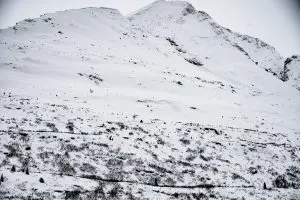
2/13 – Meteorite ramp was reported to have released full path failing at the bedrock.

2/9 & 2/10- Numerous natural avalanches occurred during this time period.
Mt tiekel (50 mile) and 38 mile ran naturally, with 38 mile depositing a small amount of debris on the road.
The entire Python Buttress failed naturally close to the ground with a crown line approximately 1/4 mile in length. Numerous avalanches in the gully to the east occured as well. Debris from both areas extended ~200 meters across flat terrain.
Gully 2 and Nicks had significant slides run into their fans.
Snowslide Gulch ran naturally and hit the road.
DOT mitigation efforts produced activity at Three Pigs and Snowslide Gulch.
Natural activity was more extensive than noted. Snowfall continued after the event refilling crowns and preventing a good look at the extent of natural activity.
1/30-Several natural persistent slab avalanches were observed in the intermountain and continental zone.
- Remote snowmachine triggered avalanche on Little Girls/ SE aspect/~3500′. Member of group reported that 2 members of a larger party were waiting on the lower angle ridges (bro bowl up route) below the slide pictured waiting for the rest of a larger group. Rider 2 went to play on a small hill nearby when rider 1 felt a large collapse and the slides pictured came down. The rest of the group gathered up and about 5 minutes after the remote trigger felt an earthshaking collapse that had alders swaying and group reported the feeling of dropping/settling a vertical foot. A noise that was described as a bomb quickly followed. The group left the area immediately and did not observe any further avalanche activity caused by the collapse. Other collapses were noted later in the day.

Weather
NWS Watches and Warnings
NONE Point forecast for Thompson Pass
DATE THURSDAY 04/28 FRIDAY 04/29
TIME (LT) 06 12 18 00 06 12 18 00 06
CLOUD COVER BK BK BK SC SC BK BK BK BK
CLOUD COVER (%) 55 65 55 35 35 55 50 60 65
TEMPERATURE 32 40 37 31 32 40 37 32 33
MAX/MIN TEMP 41 29 41 30
WIND DIR SW SW SW N E S S S SE
WIND (MPH) 3 5 3 2 3 4 4 3 5
WIND GUST (MPH)
PRECIP PROB (%) 20 10 5 5 10 30 30 30 30
PRECIP TYPE S R S S S
12 HOUR QPF 0.01 0.00 0.02 0.04
12 HOUR SNOW 0.0 0.0 0.0 0.0
SNOW LEVEL (KFT)2.2 2.6 2.3 1.9 1.8 2.4 2.2 1.4 1.2
Snow and Temperature Measurements
| Date: 04/28 | 24 hr snow | HN24W* | High Temp | Low Temp | Weekly SWE (Monday- Sunday) | April Snowfall | Season Snowfall | HS (Snowpack depth) |
| Valdez | 0 | 0.01 | 47 | 39 | 0.05 | 11 | 300 | 53 |
| Thompson Pass | 0 | 0 | 42 | 29 | 0 | 26 | 456 | 57 |
| 46 Mile | 0 | 0 | N/O | N/O | 0 | 9 | 143** | 36
|
All snowfall measurements are expressed in inches and temperature in Fahrenheit. 24 hour sample period is from 6am-6am.
* 24 hour snow water equivalent/ SWE.
** Season total snowfall measurements for 46 mile began December 1st.
Season history graphs for Thompson Pass





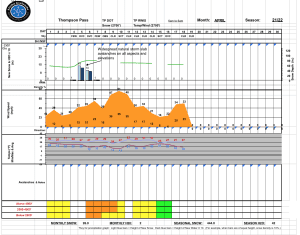
Click on links below to see a clear and expanded view of above Season history graphs
Additional Information
Winter weather began early this season, with valley locations receiving their first snowfall on the last day of Summer (September 21st). Following this storm, above average temperatures and wet weather occurred from late September through early November. During this time period Thompson Pass received 96 inches of snowfall by November 7th and Valdez recorded 7.73″ of rain.
After the 7th of November our region experienced a sharp weather pattern change. Temperatures dropped below seasonal norms and snowfall became infrequent. Between the time frame of November 7th- November 28th Thompson Pass only reported 19″ of snow with 1.1″ of Snow water equivalent (SWE). Temperatures remained below 0° F for most of the period. This cold/dry weather caused significant faceting of the snowpack, with poor structure the result.
Moderate snowfall returned to our area the last day of November and deposited 6-12 inches of new snow. The amount varied depending upon the locations’ proximity to the coast. As the storm exited on the 2nd of December it was quickly replaced by moderate to strong northeast winds.
On 12/5-12/6 Valdez received 2 feet of new snow with Thompson Pass reporting 16″. Blaring red flags like collapsing, shooting cracks and propagation in stability tests were immediately present. On 12/8 a significant remote/ sympathetic avalanche event occurred from Gully 1 through Nick’s Happy Valley.
Strong outflow winds began on 12/11 with periods of light snowfall. This has caused slab thicknesses to become variable in areas exposed to NE winds.
A fair amount of natural avalanche activity occurred during the 12/11 wind event mostly on southerly aspects. The week following this wind event fairly benign weather occurred which allowed the snowpack to adjust and for stability to improve although snowpack structure has remained poor.
On 12/21 our area received a couple inches of snow along with temperatures rising and strong outflow winds. This combination of weather kicked off a fairly significant natural avalanche cycle. Many of the slabs appeared to be deeper wind slabs that were created from the 12/11 wind event. These failed on faceted snow created in November. The event is yet another indicator of our poor snowpack structure and its inability to receive any major change in weather without the avalanche hazard rising in conjunction.
On 12/26-28 warm air moved in at elevation and caused light rain to fall up to ~4000′. A very thin rain crust was formed in many locations that was unable to support a persons weight.
A prolonged period of strong north winds began on new years day with wind speeds reaching 80 mph. As winds tapered to 30-40 mph on the 5th temperatures plummeted with lows exceeding -30 F in the Tsaina valley.
Snowfall returned to our area on 1/13 with a foot of snow reported on Thompson Pass. An additional ~6 inches of snow were received on 1/15 with settled storm totals of 2.5 feet above 5000′.
Moderate outflow winds kicked up on 1/16, but were short-lived and not wide spread. This was followed by two days of calm and mild weather.
Stormy weather returned to our area on 1/19 with 10 consecutive days of measurable precipitation. The Initial change in weather brought ~1 foot of dry snow which was quickly followed by a big warmup from 1/21-1/24, with snow line rising to 3000′. This caused the snowpack to go upside down at the surface which created a decent amount of natural wet/loose activity near sea level and a couple D3 slab avalanches on Snowslide Gulch and Mt.Tiekel. Observation of avalanche activity was limited due to continued storms and crowns being filled back in.
After 1/24, precipitation continued with temperatures slowly dropping and snow line returning to sea level. Precipitation ended on 1/29 with moderate northeast winds building wind slabs as skies cleared.
Snow water equivalent storm totals for 1/19-1/28 are as follows:
Valdez: 6.73″
Thompson Pass: 4.3″ (1/19-1/26)
46 Mile: 1.93″
A period of moderate outflow winds directly followed as the late January storms cleared out.
1/30-2/3- A period of mild weather occured with clearing skies dropping temperatures and light to moderate northerly winds. A fair number of large natural persistent avalanches were observed that occured during the previous storm and as a result of outflow winds at the tail end of the storm. First human triggered persistent slab avalanche since 12/8 reported on 1/30. This was remotely triggered.
A parade of lows began on 2/4 with precipitation measured in Valdez for 9 consecutive days. On 2/9-10 south winds ramped up to 50 mph and triggered a natural avalanche cycle with debris covering and closing the highway in a couple spots. Numerous deep persistent slab avalanches were observed in the mid elevation band. Storms continued after the natural cycle preventing a thorough record of the activity.
Following the 2/9-10 natural cycle storms continued to roll through our area with moderate to heavy accumulations occurring each day. On the 17th a more significant system moved through bringing ~20 inches of snow to Valdez and Thompson Pass with 2″ of SWE. This storm sparked a widespread natural avalanche cycle creating very large hard slab avalanches on all aspects, with many failing near the ground. Even small 30° glacial rolls were reported failing down to black ice. The November facets have been reactive this year every time there has been a major change in weather and this storm was no exception.
Our area received a quick break in the weather from 2/19-20 allowing the snowpack to settle some. This reprieve was followed by a foot of snow at sea level and 2 feet at upper elevations, that arrived on the night of 2/21 accompanied by strong winds. Very little natural activity was noted when skies cleared the 23rd. The exception to this was a full depth hard slab that failed in steep rocky terrain above cascade creek (see avalanche activity).
2/24-26 saw light to moderate precipitation with temperatures going above freezing at valley locations region wide.
3/1-2- Clearing skies with very little wind formed widespread surface hoar up to 5000′
3/3-3/6- Snowfall returns with a strong storm that delivered 20-24 inches of new snow to valley locations and more above. Continental locations were warmer with less precipitation, 46 mile received .5″ of rain. Strong southeast wind accompanied this storm with gusts to 40 mph.
3/6-3/7- Clear weather with light winds. Numerous skier triggered avalanches D1-D3 on 3/3 BSH. Mostly north aspects,4-6000′.
3/8-3/12- Incremental snowfall with above freezing temps up to 3000′ during the day.
3/13- Moderate outflow wind event with north winds reaching speeds in the 50’s through Thompson Pass.
3/14-15- Clear with diminishing north wind.
3/16-3/18- return to incremental snowfall and cloudy skies
3/19-3/22- Period begins with clear skies and calm winds. This transitioned to an outflow wind event on the 21st with with gusts up to 76 mph recorded on Thompson Pass. Sensitive wind slabs observed, with several natural and human triggered D1-2’s reported.
3/23-28- Unsettled weather/ incremental snowfall with short periods of clearing.
3/29-4/4- Clear with light winds creates a period of stable conditions
4/5-6- Winter returns with 3 feet of accumulation at upper elevations in the coastal zone. Amounts slowly decreased as you move away from the coast with with 12-16 inches for the continental zone.
4/9-11- Moderate to strong north winds stripped and redistributed a lot of new snow in wind channeled areas creating slabs below ridgelines and mid slope. These have been reactive to human triggers as recently as 4/11.
4/12-20- Benign weather with clear and cold nights has allowed the snowpack to settle with stable conditions existing.
4/21-22- A Pacific storm brushes our area producing 2-6 inches of snow above 4000′. This storm brought warmer temperatures with valley locations remaining above freezing for the first time in the Spring. This has caused a quick transition from a Winter to Spring snowpack.
4/23-Present- Temperatures increased significantly which has caused the snowpack to go into Spring shed cycle with significant avalanche activity occurring on solar aspects.
Announcements
Condolences go out to the family and friends of a Local Valdez Legend that passed away on the twenty fifth of April in the Chugach mountains. His passing has left a huge hole in the community, he will not be forgotten. Limited details are included in the avalanche activity section.
The avalanche hazard will begin as moderate at all elevations and will move to considerable on solar aspects during the heat of the day. A significant rise in temperatures over the last week has kicked the spring shed cycle into full gear. Significant wet loose avalanche activity has been occurring on solar aspects at all elevations during the heat of the day. Over the last week, wet loose activity has triggered deep slabs that have produced large avalanches running full path. On north aspects above 5000′ persistent slabs up to 1 foot in depth remain possible to trigger. Avoid exposure to cornices, steep solar aspects during the heat of the day and traveling above terrain traps or exposure in steep north facing terrain above 5000′.
Posted 04/28 7:45 am.
The last public avalanche forecast of the year will be posted on Saturday April 30.
During the month of April every public observation will be entered into a raffle to win a Black Diamond shovel. Raffle will be held at the avalanche center fundraiser April 30 at the Valdez Brewery.
Click the + Full Forecast button below for a list of current avalanche problems, travel advice, weather resources and more.
The Valdez Avalanche Center produces forecasts Wednesday- Sunday.
Help to improve your local avalanche center and contribute an observation to the website. You can also contact me directly at ga**********@ya***.com (907) 255-7690.
